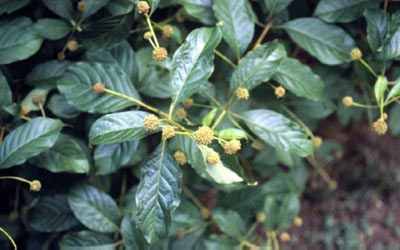Genus: Cephalanthus

Photo © by Steven Clemants
Taken at the Brooklyn Botanic Garden, NY, 1999.
Nomenclature
Cephalanthus L., Sp. Pl. 95. 1753. Gen. Pl. 42. 1754. LECTOTYPE: Cephalanthus occidentalis L. designated by Britton & Brown (1913).Key to the species of Cephalanthus
List of Cephalanthus Species
References to Cephalanthus
- Andersson, S. et.al. 2002. Floral scents in butterfly-pollinated plants: Possible convergence in chemical composition. Bot. J. Linn. Soc. 140: 129-153.
- Bakhuizen Van Der Brink, R. C. 1970. Nomenclature and typification of the genera of Rubiaceae-Naucleeae and a proposal to conserve the generic name Nauclea L. Taxon 19: 468-80.
- Battacharya, M.; Primack, R. B.; Gerwein, J. 2003. Are roads and railroads barriers to bumblebee movement in a temperate suburban conservation area? Biol. Conserv. 109: 37-45.
- Bremer, B.; Andreasen, K.; Olsson, D. 1995. Subfamilial and tribal relationships in the Rubiaceae based on rbcL sequence data. Ann. Missouri Bot. Gard. 82: 383-97.
- Britton, Nathaniel L. 1920. Cephalanthus occidentalis. Addisonia 5: 17-8.
- Deane, W. 1902. Remarkable persistence of the button-bush. Rhodora 4: 243-4.
- Faber-Langendoen, D.; Dina, S. J. 1987. Growth response of Cephalanthus occidentalis L. (buttonbush) to varying light levels and flooding. Trans. Missouri Acad. Sci. 21: 55-62.
- Faber-Langendoen, D.; Maycock, P. F. 1989. Community patterns and environmental gradients of buttonbush, Cephalanthus occidentalis, ponds in lowland forests of southern Ontario. Canad. Field-Naturalist 103: 479-85.
- Glenn, Steven D. 1997. Bombus sp. visiting flowers of Cephalanthus occidentalis.
- Green, W. E. 1947. Effect of water impoundment on tree mortality and growth. J. Forest. 45: 118-20.
- Hupp, C. R. 1986. Upstream variation in bottomland vegetation patterns, northwestern Virginia. Bull. Torrey Bot. Club 113: 421-30.
- Imbert, F. M.; Richards, J. H. 1993. Protandry, incompatibility, and secondary pollen presentation in Cephalanthus occidentalis (Rubiaceae). Amer. J. Bot. 80(4): 395-404.
- McCarron, J. K.; McLeod, K. W.; Conner, W. H. 1998. Flood and salinity stress of wetland woody species, buttonbush (Cephalanthus occidentalis) and swamp tupelo (Nyssa sylvatica var. biflora). Wetlands 18: 165-175.
- McIninch, S. M.; Garbisch, E. W.; Biggs, D. 1994. The benefits of wet-acclimating woody wetland plant species. Wetland Journal 6: 19-23.
- McVaugh, R. 1952. Suggested phylogeny of Prunus serotina and other wide ranging phylads in North America. Brittonia 7: 317-346. (And other genera)
- Middleton, B. 2000. Hydrochory, seed banks, and regeneration dynamics along the landscape boundaries of a forested wetland. Plant Ecology 146: 169-184.
- Quimby, M. W. 1934. The morphology and anatomy of certain above-ground parts of Cephalanthus occidentalis L. M.S. Thesis Cornell Univ., Ithaca, NY24 figs. + 45 p.
- Snyder, S. A. 1991. Cephalanthus occidentalis. ()